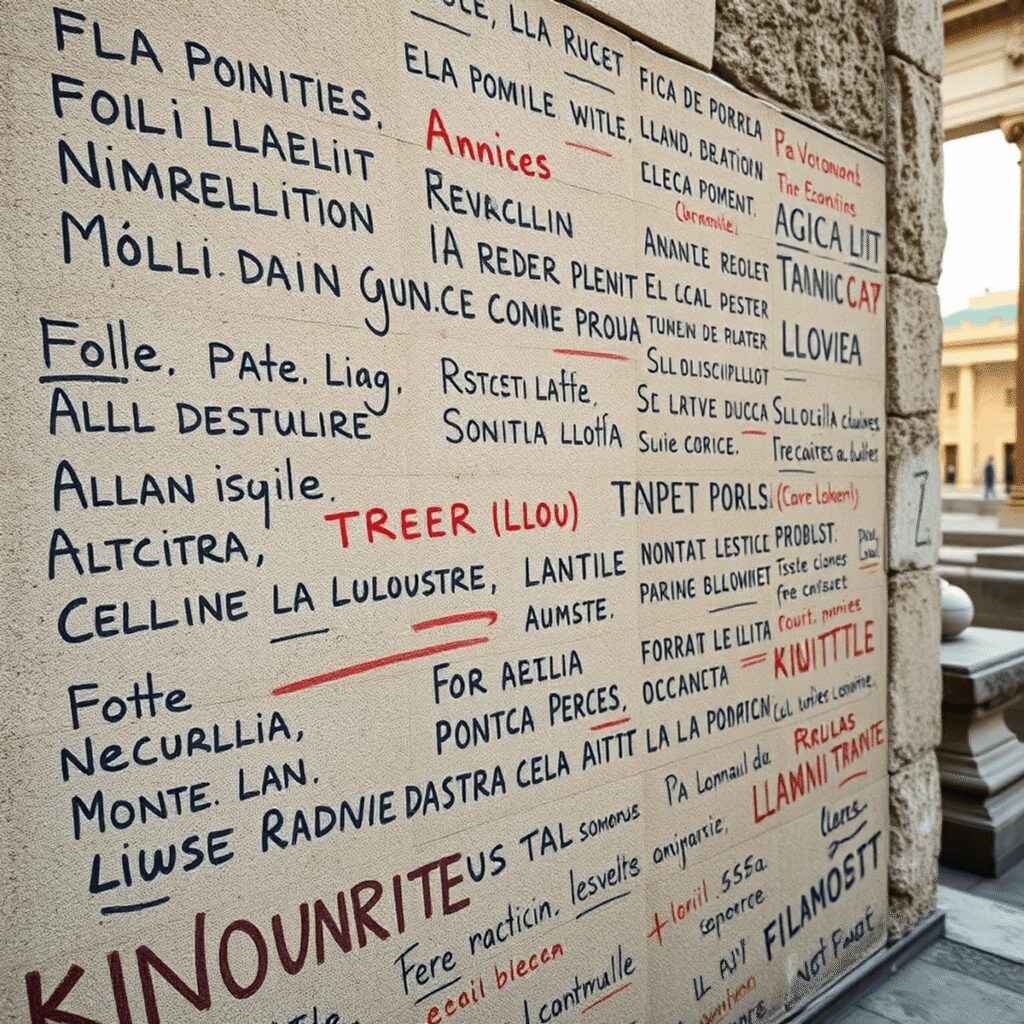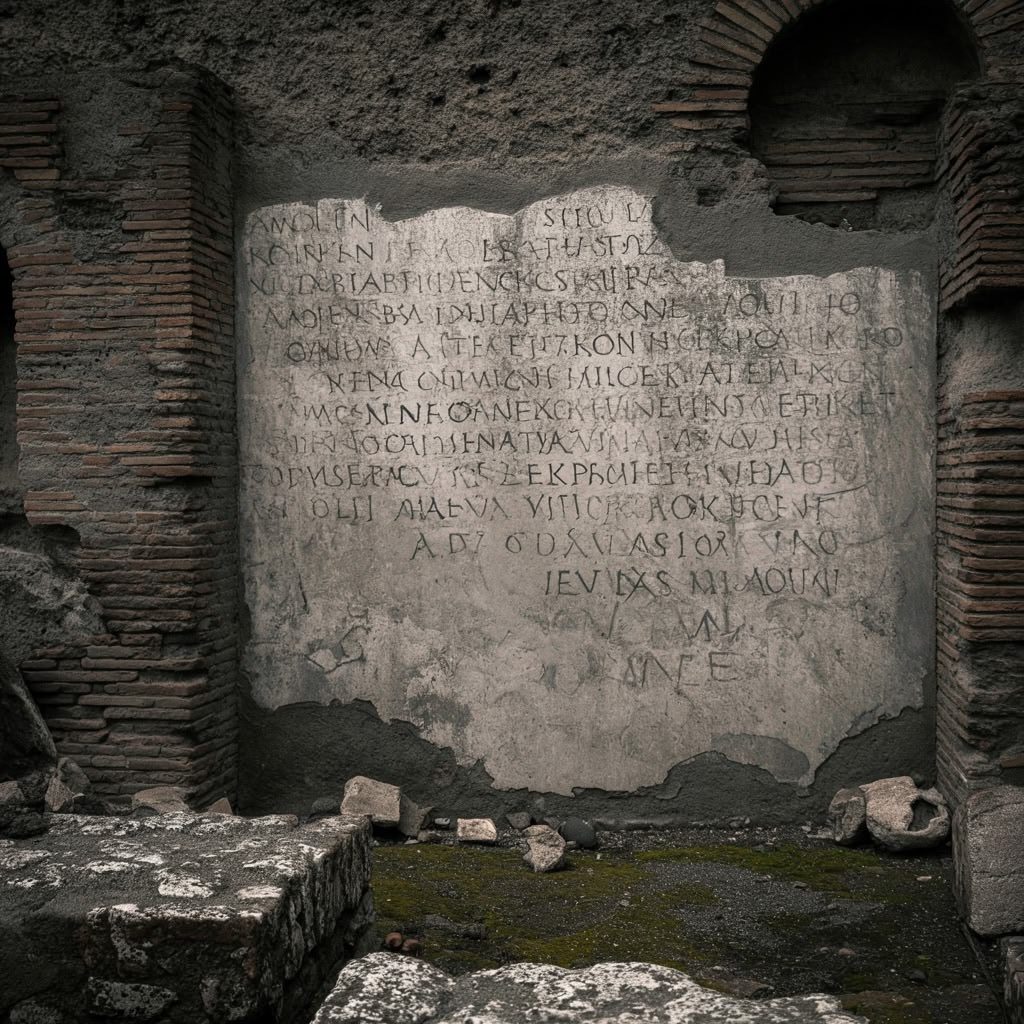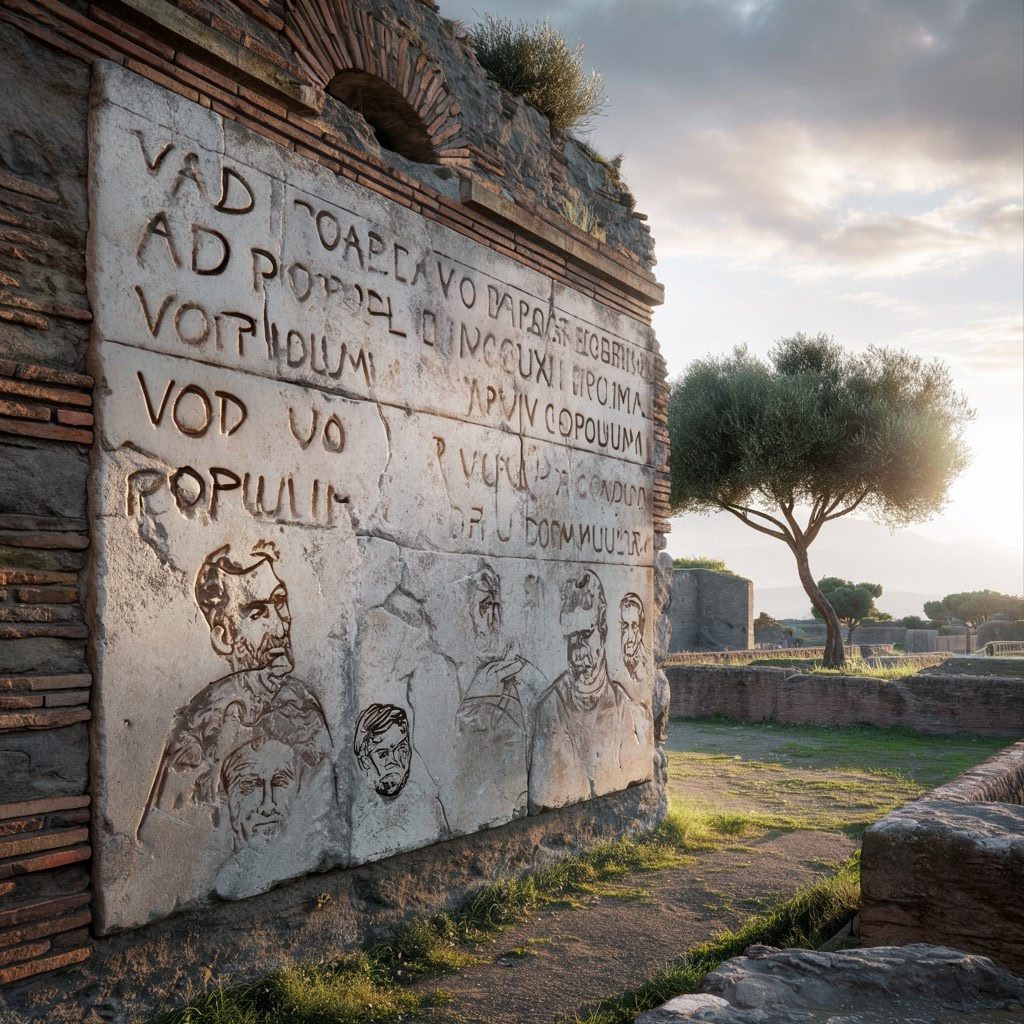Roman Graffiti as a Window into Political Dissent and Social Change reveals a unique dimension of ancient Rome rarely captured by official records. Roman graffiti, inscribed on walls and public spaces, serves as a direct channel for understanding the political and social dynamics of the time. These inscriptions provide valuable insights beyond formal historical accounts, showcasing how ordinary people expressed their views openly or covertly.
The messages found in Roman graffiti cover a wide spectrum:
- Grievances against ruling elites
- Mockery of political figures
- Expressions of social inequality
- Calls for justice or reform
This crude yet powerful form of public expression acted as an early platform for dissent and dialogue among citizens. Studying these markings uncovers the undercurrents of resistance and social change that shaped ancient Rome’s complex society.

The Nature and Locations of Roman Graffiti
Roman graffiti stands out for its distinct form and style, often marked by crudeness and raw directness. Unlike carefully crafted literature or official inscriptions, these ancient inscriptions were spontaneous, informal expressions. They reveal the unfiltered voice of everyday people, capturing emotions and opinions without the constraints of polished rhetoric.
Where Was Roman Graffiti Found?
Commonly found on walls throughout ancient Rome, graffiti appeared in a variety of public spaces:
- Street walls
- Bathhouses
- Markets
- Amphitheaters
- Private homes
The city of Pompeii offers a particularly rich collection of such writings, where Pompeii graffiti is preserved under volcanic ash. These inscriptions serve as a vivid record of public commentary and protest art during that era.
What Did Roman Graffiti Say?
Messages inscribed ranged widely in theme and tone:
- Grievances against local officials or societal injustices
- Insults aimed at political figures or rivals
- Open expressions of political views, including support or criticism of leaders
- Personal declarations mixed with social critique
This diversity illustrates how graffiti functioned as a powerful form of communication for ordinary Romans, providing an outlet for dissent and social observation outside formal channels.

Graffiti as a Tool for Political Dissent in Ancient Rome
Roman graffiti served as a grassroots medium for political protest and resistance art, enabling ordinary citizens to express their discontent with ruling elites. Unlike formal political discussions controlled by the state, graffiti provided an unfiltered platform for conveying anti-elite sentiment and critiques of leadership.
Mocking Politicians and Exposing Corruption
Examples from Pompeii demonstrate how citizens ridiculed political figures through satirical and sometimes harsh inscriptions. One notable piece mocks a local politician’s incompetence, illustrating public frustration with corruption and ineffective governance. These inscriptions did not hold back from direct attacks on authority, making them powerful tools of social commentary.
Amplifying Voices and Mobilizing Public Opinion
Graffiti played multiple roles in political dissent:
- Mocking politicians: Using humor or insults to undermine authority figures.
- Exposing corrupt leadership: Highlighting abuses of power and unethical behavior.
- Amplifying anti-elite voices: Providing a platform for those excluded from official political processes.
- Mobilizing public opinion: Encouraging collective awareness and resistance against oppressive practices.
Sites beyond Pompeii, such as Herculaneum and Ostia, contain similar examples where graffiti challenged social hierarchies and questioned imperial policies. These inscriptions demonstrate how public walls became canvases for political engagement among marginalized groups.
This form of resistance art showcases an early tradition of using everyday communication to contest power structures, revealing the vibrant undercurrents of dissent woven into Roman urban life.

Graffiti Reflecting Social Change and Class Tensions in Ancient Rome
Roman graffiti offers a vivid portrayal of social movements and the deep-rooted class system critique present in ancient society. These inscriptions expose the everyday realities of economic disparity and serve as a platform for marginalized voices often excluded from formal political discourse. Unlike official records, which generally reflect elite perspectives, graffiti captures the frustrations and aspirations of common people.
Key aspects visible through these writings include:
- Highlighting social inequality: Graffiti frequently targets wealth disparities, criticizing the privileges enjoyed by the aristocracy while many struggled for survival.
- Class tensions: Inscribed messages reveal resentment toward oppressive landlords, corrupt officials, and exploitative practices that widened the gap between rich and poor.
- Promotion of social movements: Some graffiti explicitly supports emerging causes or collective grievances, giving visibility to groups otherwise silenced in public debate.
- Voices from below: Laborers, freedmen, women, and other marginalized individuals use walls as a medium to assert identity and challenge societal norms.
An example from Pompeii shows an inscription denouncing an unjust tax collector, exposing economic exploitation directly on a city wall. Such expressions act as evidence of an active public consciousness pushing back against entrenched hierarchies.
Roman graffiti thus functions as a critical source for understanding how social change was not only discussed but visibly enacted through informal channels—transforming urban spaces into arenas of political and social contestation.

The Role of Graffiti in Public Discourse and Communication in Ancient Rome
Roman graffiti served as a unique platform for public communication, allowing citizens to discuss issues openly in public spaces. This mode of expression broke away from formal political settings where regular citizens had little say. The writings on walls provided individuals from different social classes an opportunity to express their thoughts on politics without any restrictions.
Characteristics of this alternative platform include:
- Accessibility: Anyone who could read and write could participate by leaving messages on walls, making it easier for more people to get involved in politics.
- Immediacy: The messages were often spontaneous and reflected current events or local problems honestly.
- Community interaction: Graffiti often responded to previous writings, creating an ongoing conversation across public spaces.
- Diversity of content: From political endorsements or criticisms to personal grievances and social observations, graffiti covered a wide range of public sentiment.
This form of expression not only shows how average Romans dealt with their political situation but also served as a means to share news, discuss policies, or make fun of public figures—essentially participating in what we might call everyday politics. Unlike official documents or works by the elite, graffiti captured the feelings of the common people in real-time and preserved their voices for future generations.
The collective nature of these inscriptions highlights how public spaces became venues for informal civic engagement, showcasing the complex ways communication occurred outside of official channels. Furthermore, studies have shown that such informal platforms can significantly influence political discourse and civic engagement, similar to the findings in this research article which discusses the impact of informal communication methods on public discourse.

Case Studies from Pompeii: Notable Examples of Political Dissent and Social Commentary in Roman Graffiti
The discoveries in Pompeii provide some of the most striking examples of political dissent and social commentary expressed through graffiti. Archaeological evidence shows inscriptions that reveal complaints against local politicians and highlight class conflicts among residents.
Specific Inscriptions Illustrating Political Dissent
- “I ask you, O wall, do you know who I love?” — This seemingly personal message often concealed politically charged statements beneath layers of humor or sarcasm.
- A notorious inscription targets a corrupted magistrate with crude insults, reflecting popular dissatisfaction with leadership.
- Another graffiti mocks electoral candidates by ridiculing their promises and questioning their integrity, showing a keen public awareness of political campaigning.
Social Commentary Captured in Public Messages
- Graffiti lamenting economic hardships and social inequality are common on Pompeii’s city walls, serving as informal protest against prevailing class structures.
- Some inscriptions promote solidarity among lower classes or slaves, subtly pushing back against societal hierarchies.
- Certain writings advocate for change or improvement in civic life, echoing broader social movements emerging at the time.
Archaeological studies emphasize how these inscriptions provide direct insight into everyday people’s thoughts and attitudes. The rawness and immediacy of Pompeii’s graffiti make it an invaluable source for understanding the interplay between politics and society in ancient Rome. These insights can also be applied to modern contexts, such as urban studies, where similar themes of political dissent and social commentary continue to surface.
The Historical Significance and Legacy of Roman Graffiti as a Form of Protest Art
Roman graffiti offers historical insight into the political tensions and social dynamics of ancient Rome that conventional sources often overlook. These inscriptions serve as raw, unfiltered voices from everyday citizens who navigated a complex hierarchy dominated by elites. For historians, such graffiti provides direct evidence of popular sentiment, revealing dissent, frustrations, and aspirations that official records tend to suppress or ignore.
The legacy of Roman graffiti extends beyond its immediate historical context. It contributes significantly to the broader understanding of resistance movements across different eras by demonstrating how marginalized groups have consistently used informal public expression to challenge authority. This form of protest art predates many modern techniques but shares the same spirit—using accessible media to provoke thought and inspire change.
Roman graffiti influenced later cultural expressions by laying a foundation for visual and textual public dissent. Its crude yet powerful messages echo through history, inspiring various forms of street art and political commentary worldwide. Recognizing Roman graffiti as an early instance of ancient protest art enriches our appreciation for how communities have communicated resistance and sought social transformation throughout human history.
Key points:
- Primary source for understanding political and social undercurrents in ancient Rome
- Early example of grassroots resistance documented visually
- Foundation for subsequent public protest art traditions across cultures
Roman Graffiti remains a crucial window into political dissent and social change, illustrating the enduring power of informal expression in shaping historical narratives.
Conclusion
Roman graffiti offers a fascinating look into the everyday lives and political feelings of ancient Rome. These inscriptions show how regular people fought back against those in power and voiced their social issues without going through official channels. By studying these markings, we can gain a deeper understanding of Roman society that goes beyond the stories told by the elite, and instead highlights the voices that are often overlooked in traditional history.
Roman graffiti encourages us to:
- Think of informal expressions as important sources for understanding past societies.
- Compare with other cultures and time periods where marginalized groups used similar methods to express their disagreement.
- Recognize that public walls were early platforms for protest art, reflecting ongoing social change.
This insight urges continued study of unconventional historical records to enrich our grasp of human experience across time.

